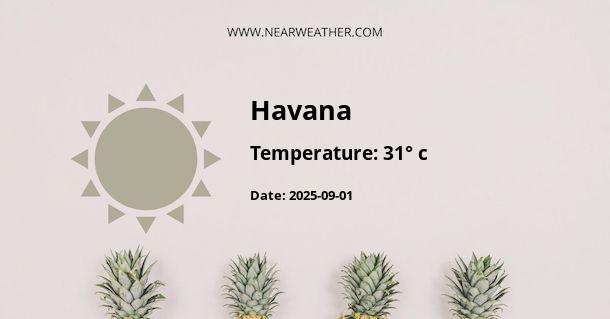Havana, Cuba: A Comprehensive Weather Guide
Havana, the capital city of Cuba, is renowned for its rich history, vibrant culture, and stunning architecture. One key aspect that greatly influences the experience of residents and tourists alike is its unique climate. Understanding the weather patterns and conditions throughout the year is crucial for anyone planning a visit to this enchanting city. Let's delve into a detailed analysis of Havana's climate and weather year-round.
Climate Overview
Havana experiences a tropical climate, more specifically a tropical savanna climate (Köppen climate classification Aw). This type of climate is characterized by distinct wet and dry seasons, with relatively consistent temperatures throughout the year.
Temperature
The temperature in Havana remains warm to hot throughout the year, with relatively small variations. The hottest months are typically June through August, with average high temperatures around 32°C (90°F). The coolest months are December through February, with average highs around 25°C (77°F). The year-round warm temperatures make Havana an appealing destination for those seeking a tropical climate.
Precipitation
Havana experiences a distinct wet season from May to October, with the heaviest rainfall occurring in May and October. The dry season spans from November to April, with significantly less rainfall during these months. The annual precipitation in Havana averages around 1,200 mm (47 inches), with the majority of the rain falling during the wet season.
Humidity
Due to its coastal location, Havana experiences high humidity levels throughout the year. The humidity peaks during the wet season, making the weather feel even warmer. The average relative humidity in Havana ranges from 70% to 80%.
Wind
Havana is characterized by consistent northeastern trade winds, which bring a refreshing breeze to the city. These winds help moderate the temperature and provide relief from the humidity, especially during the hotter months. The average wind speed in Havana is around 9 km/h (5.6 mph).
Sunshine
Havana enjoys abundant sunshine year-round, with an average of 7 to 8 hours of sunshine per day. The sunniest months are typically December through April, providing ample opportunities for outdoor activities and sightseeing.
Extreme Weather
While Havana generally experiences favorable weather conditions, it is important to note that the city is susceptible to occasional extreme weather events. The hurricane season in the Caribbean runs from June to November, with the highest likelihood of hurricanes and tropical storms occurring in September and October. Visitors should stay informed about weather forecasts and potential storm developments during this period.
Best Time to Visit
The ideal time to visit Havana is during the dry season, particularly from December to April, when the weather is most pleasant. This period offers ample sunshine, lower humidity, and less rainfall, providing optimal conditions for exploring the city's attractions and soaking up its vibrant atmosphere.
Conclusion
In conclusion, Havana's climate is characterized by its tropical savanna climate, with warm temperatures, distinct wet and dry seasons, high humidity, refreshing trade winds, abundant sunshine, and occasional extreme weather events. Understanding these weather patterns is essential for anyone planning a trip to Havana, ensuring an enjoyable and memorable experience in this captivating city.
A - Havana's Latitude is 23.133020 & Longitude is -82.383041.
A - Weather in Havana is 15° today.
A - Climate Conditions in Havana shows scattered clouds today.
A - Humidity in Havana is 94% today.
A - Wind speed in Havana is 3.71 km/h. today.
